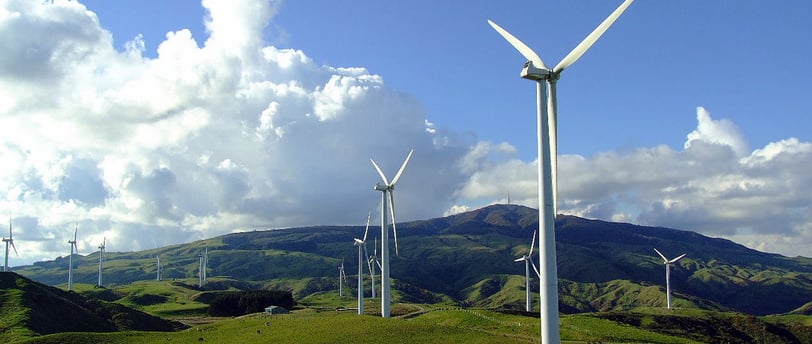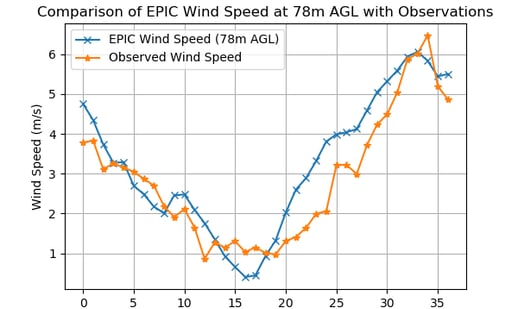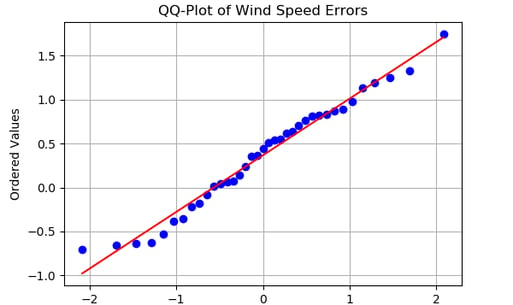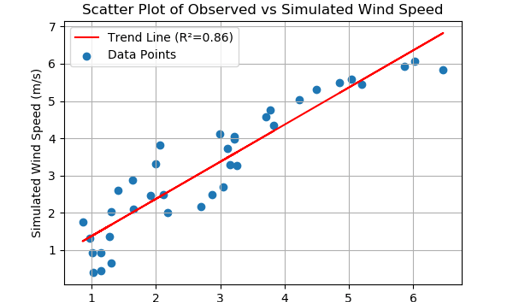Powered by EPIC Atmospheric Simulation Method
Case Study 1 : Enhancing Wind Farm Operations with EPIC Wind Energy Forecasts


In the renewable energy industry, accurate and timely wind speed forecasts are crucial for optimizing wind farm operations. High-precision forecasts enable operators to maximize energy production, improve turbine performance, and minimize operational risks. At EPIC Prognostics, we have developed the Enhanced Predictions through Improved Conditions (EPIC) method, designed to significantly improve the accuracy of wind speed forecasts. This case study demonstrates how EPIC was applied to a specific wind farm site, yielding results that showcase its potential to revolutionize wind farm efficiency.
The Challenge
Wind turbines are most effective when wind speed forecasts at their hub height—78 meters above ground level (AGL)—are accurate. However, predicting wind speed at this height poses significant challenges due to complex atmospheric dynamics influenced by local topography and fluctuating weather conditions. Traditional models often struggle to account for these complexities, resulting in discrepancies between forecasted and observed wind speeds. The EPIC method addresses these challenges by enhancing traditional models with improved atmospheric condition inputs and refined prediction algorithms.
Our Approach
Using the EPIC method, we conducted a simulation of wind speed forecasts at 78 meters AGL over a six-hour period from 2021-03-25 01:00 to 2021-03-25 07:00, with data points recorded at 10-minute intervals. The simulated results were then compared to observed wind speed data collected from the RW-Turb (Rainfall Wind Turbine or Turbulence) station. The observational data was sourced from the paper "Three months of combined high resolution rainfall and wind data collected on a wind farm."
The comparison was analyzed using several key statistical metrics to assess the accuracy of the EPIC method:
Mean Absolute Error (MAE): 0.60 m/s
Root Mean Square Error (RMSE): 0.72 m/s
Mean Bias Error (MBE): 0.37 m/s
Coefficient of Determination (R²): 0.79
Correlation Coefficient (R): 0.93
Standard Deviation of Error (SDE): 0.62 m/s
Key Findings
High Accuracy with Tight Error Margins: The EPIC method demonstrated a very strong correlation coefficient (R) of 0.93 with the observed wind speed data, indicating a strong linear relationship between the forecasted and actual values. The high correlation is critical for operational forecasting, ensuring that EPIC accurately captures the minute-by-minute variations in wind speed at the hub height.
The time series plot above compares EPIC-forecasted wind speed with observed data, showing a close alignment of the two curves. This close match illustrates EPIC’s ability to predict wind speed trends accurately, especially during periods of rapid changes.
Precision in Short-Interval Forecasts: Wind farm operations require precise forecasts at short intervals, typically around 10 minutes, to adjust turbine settings and manage energy output effectively. The EPIC method's MAE of 0.60 m/s and RMSE of 0.72 m/s reflect high accuracy, essential for these short-interval forecasts. These values indicate that the EPIC-forecasted wind speed is very close to the observed data, with minimal discrepancies. This level of precision ensures that operators can make timely adjustments to turbine operations, minimizing energy loss and mechanical wear.
The slightly higher RMSE compared to MAE suggests that while most forecasts are highly accurate, there are occasional deviations, still within an acceptable range for operational decision-making.
Manageable Forecast Bias: The MBE of 0.37 m/s indicates a slight positive bias, meaning that EPIC tends to overestimate wind speed by an average of 0.37 m/s. While minor, this bias is essential to note for operators who rely on precise energy output forecasts. Fortunately, this bias can be easily adjusted for in operational strategies, ensuring accurate energy predictions and optimal turbine settings.
Consistent and Reliable Error Distribution: The Standard Deviation of Error (SDE) of 0.62 m/s demonstrates the consistency of EPIC’s forecasts, with most errors falling within a narrow range. The QQ-plot below confirms that the errors are approximately normally distributed, with only minor deviations at the tails, ensuring that EPIC's forecasts are reliable under various conditions.
The alignment of the data points with the red line in the QQ-plot indicates that the distribution of errors is close to normal, confirming the reliability of EPIC's wind speed forecasts.
The Importance of 10-Minute Interval Forecasts
In wind farm operations, the ability to forecast wind speed at short intervals, such as every 10 minutes, is crucial. Wind speed can fluctuate rapidly due to changes in atmospheric conditions, and these fluctuations directly impact the performance of wind turbines. Accurate short-interval forecasts allow operators to:
Optimize Turbine Performance: By adjusting turbine settings in near real-time, operators can ensure that turbines operate at peak efficiency, reducing mechanical stress and prolonging the lifespan of equipment.
Maximize Energy Production: With precise 10-minute interval forecasts, energy output can be optimized, ensuring that turbines are generating the maximum possible power at all times.
Enhance Grid Stability: Accurate short-term forecasts help in better matching energy supply with demand, contributing to grid stability and reducing the risk of blackouts or energy shortages.
Conclusion
This case study illustrates the effectiveness of the EPIC method in providing accurate wind speed forecasts at the critical turbine hub height. The precision of EPIC's forecasts, particularly at 10-minute intervals, makes it an invaluable tool for wind farm operators looking to optimize their operations, enhance energy production, and minimize operational risks.
At EPIC Prognostics, we are dedicated to advancing wind speed forecasting technology through our innovative EPIC method. By providing high-accuracy forecasts, EPIC helps wind farm operators achieve their energy goals with greater efficiency and reliability.
If you're interested in optimizing your wind farm operations with cutting-edge wind speed forecasting tools, contact us today to learn more about how EPIC can benefit your business.








